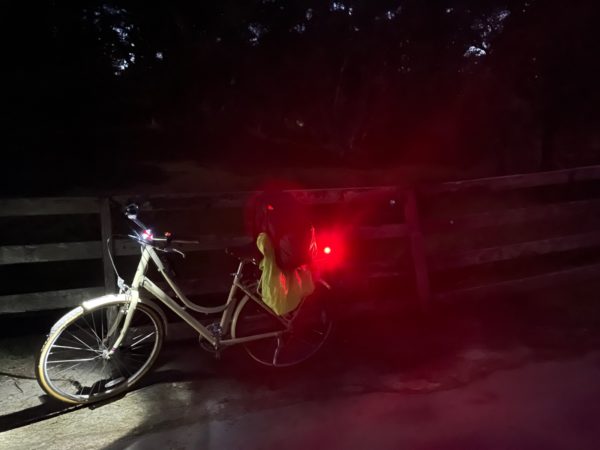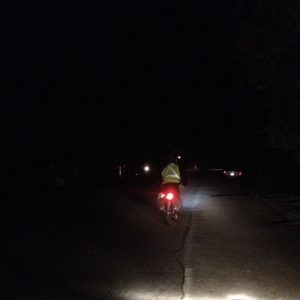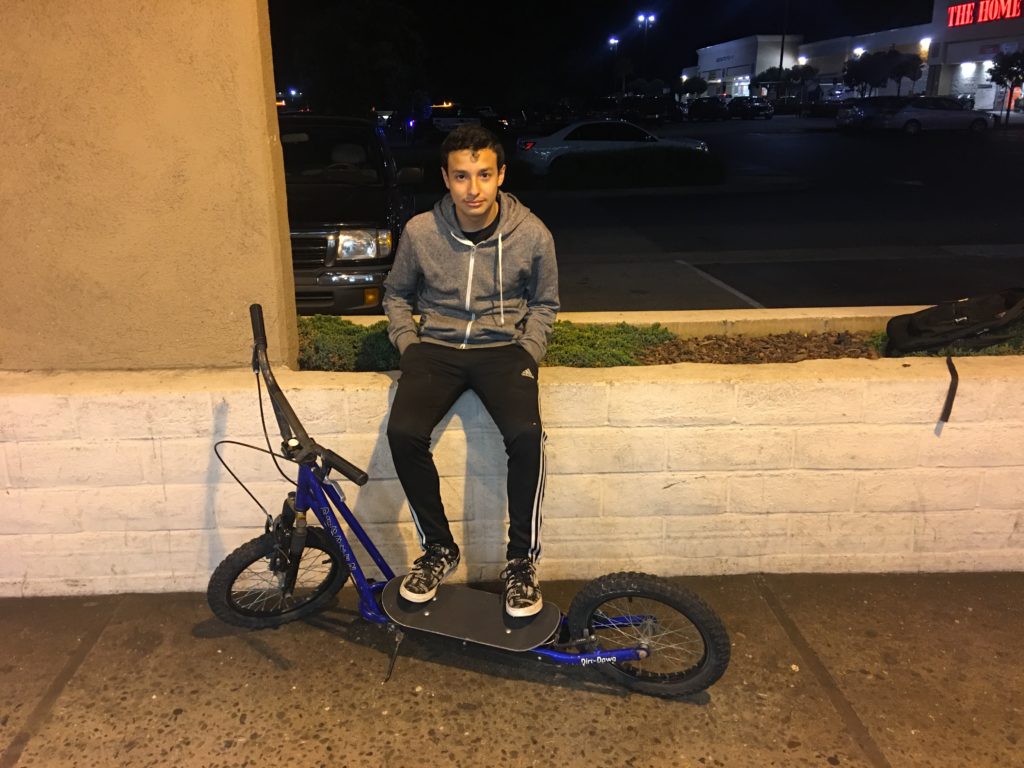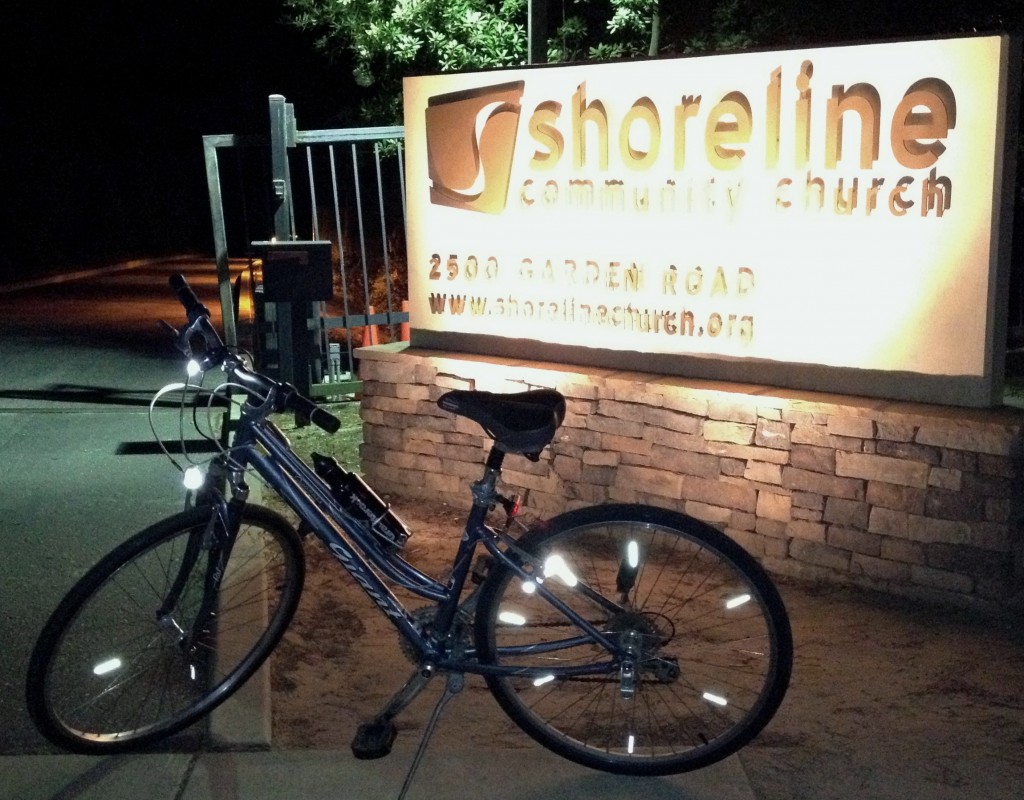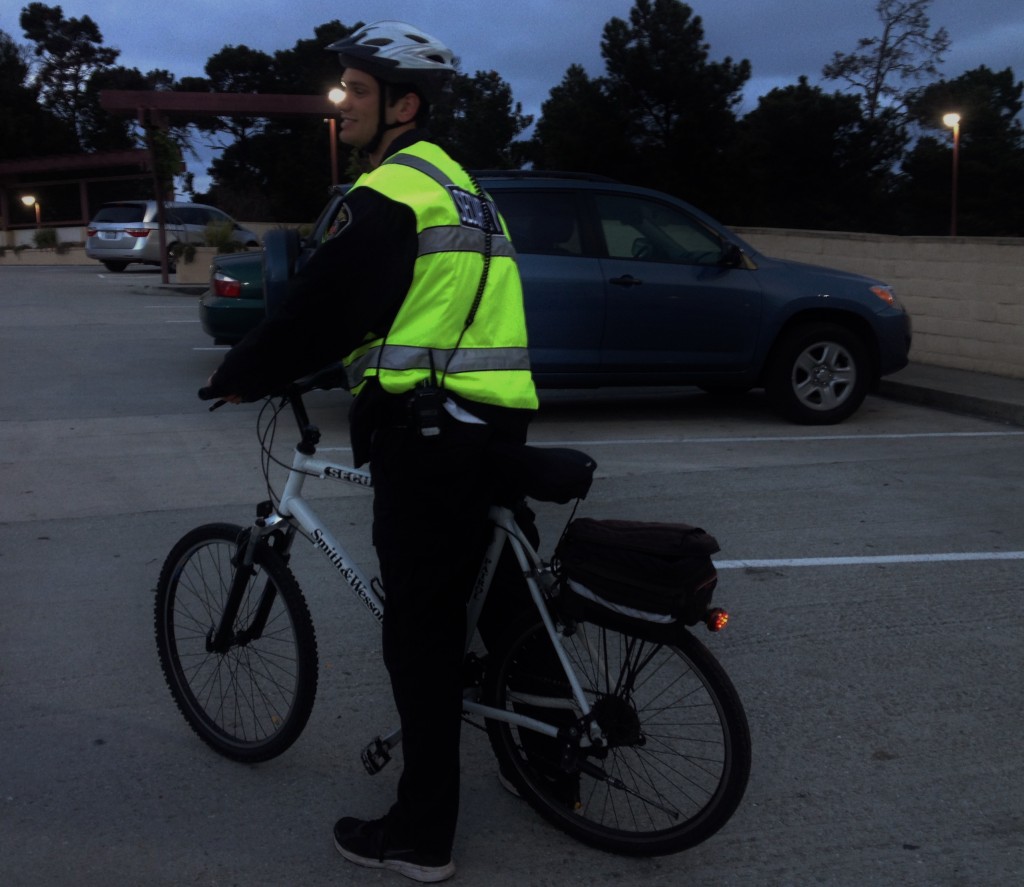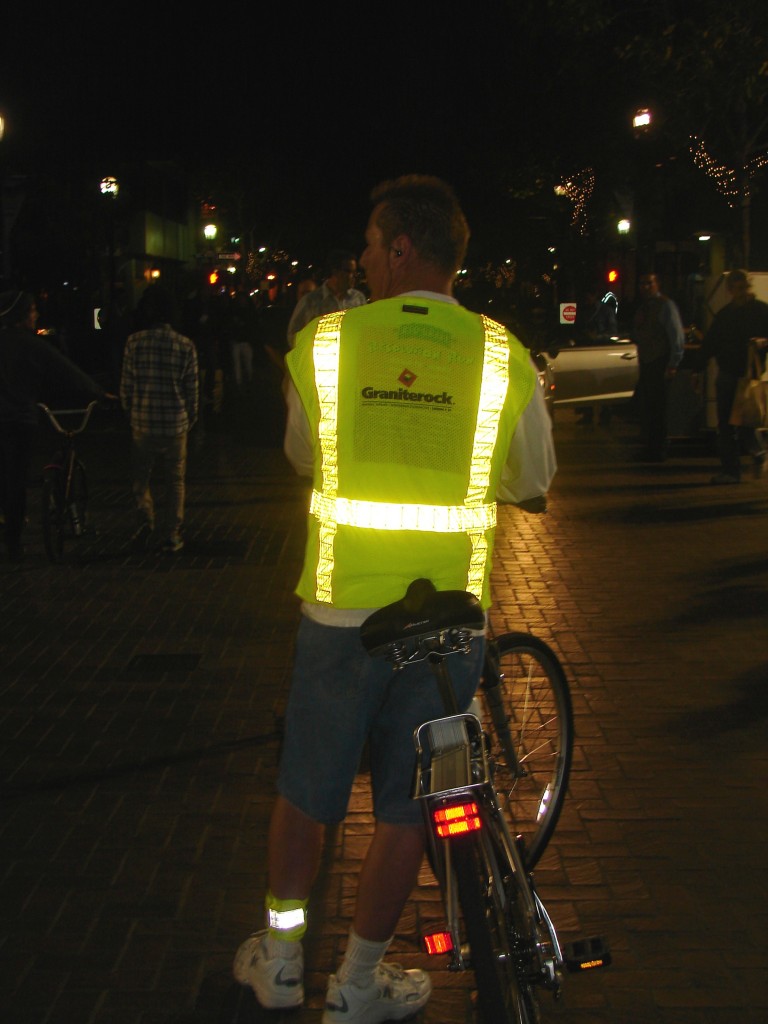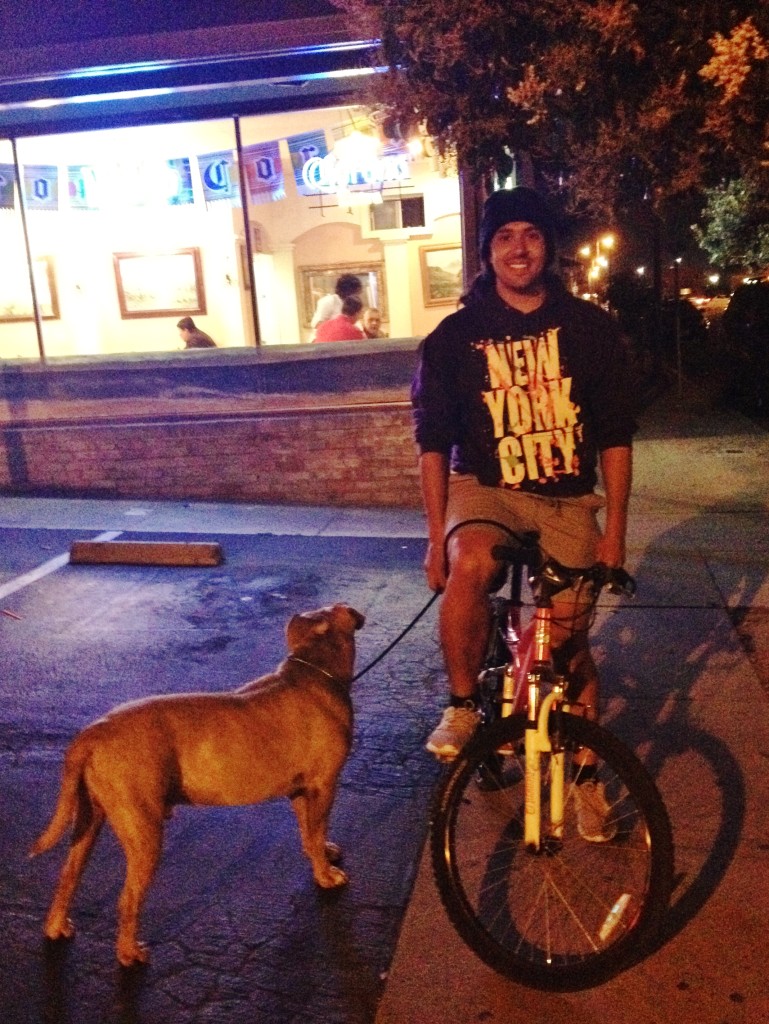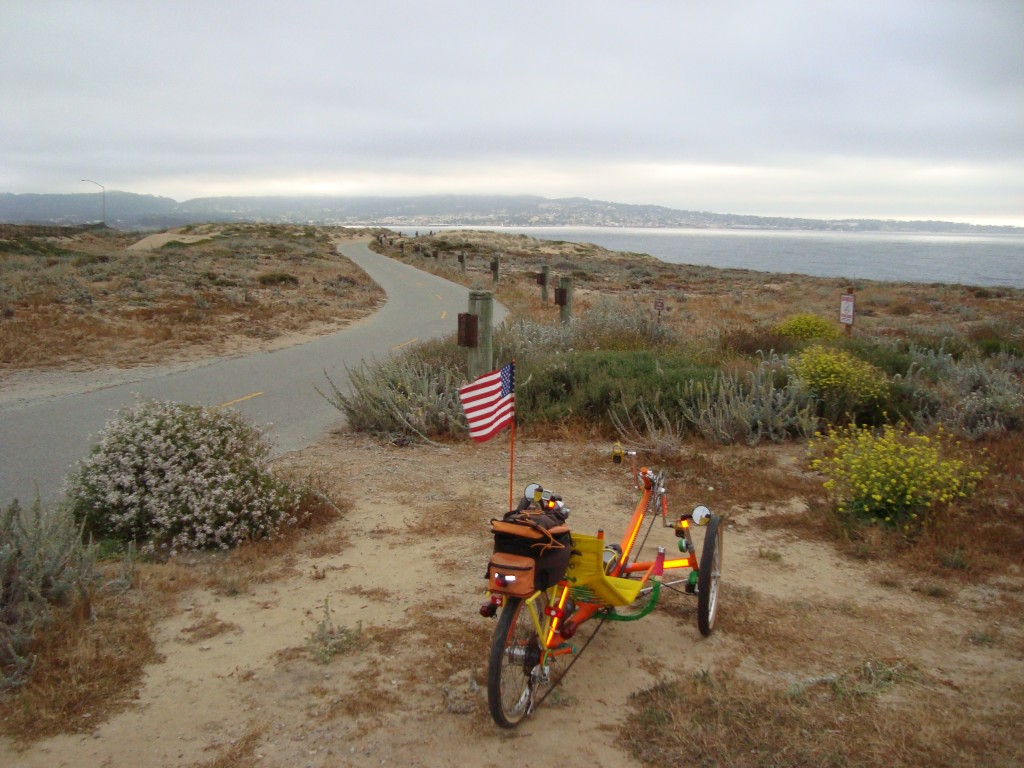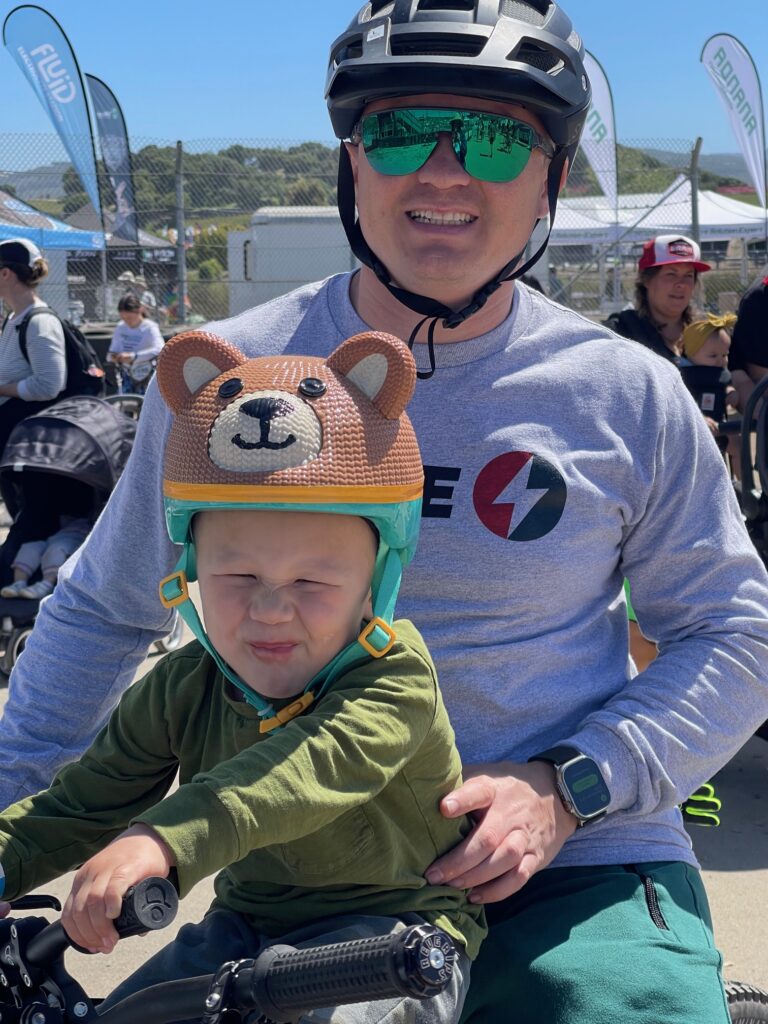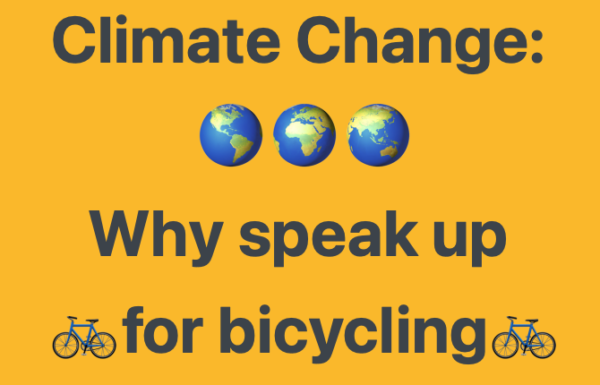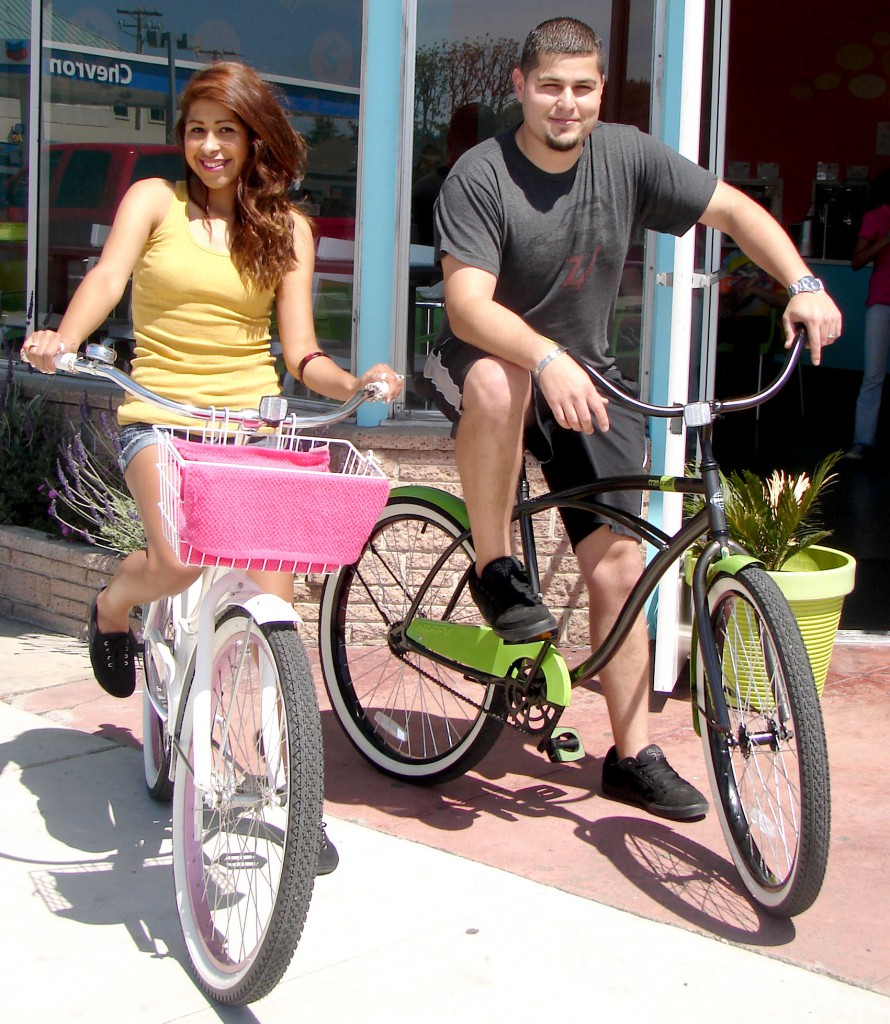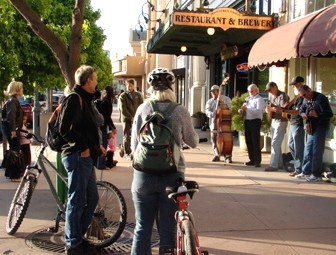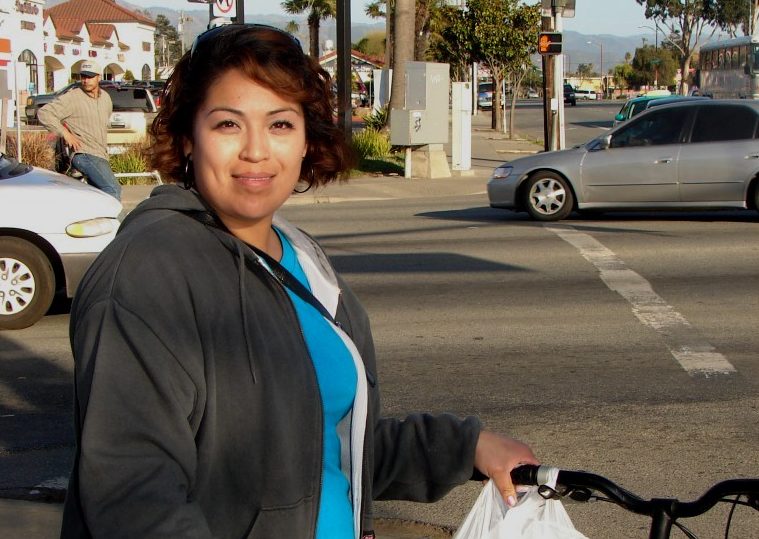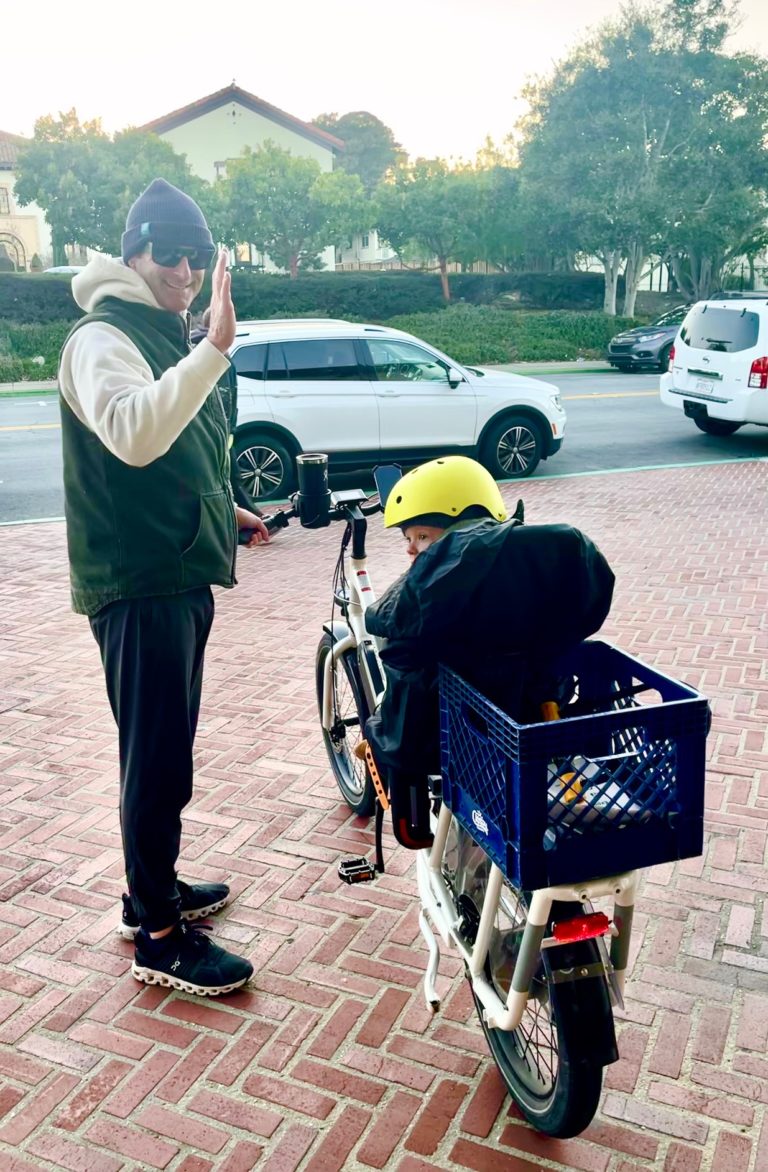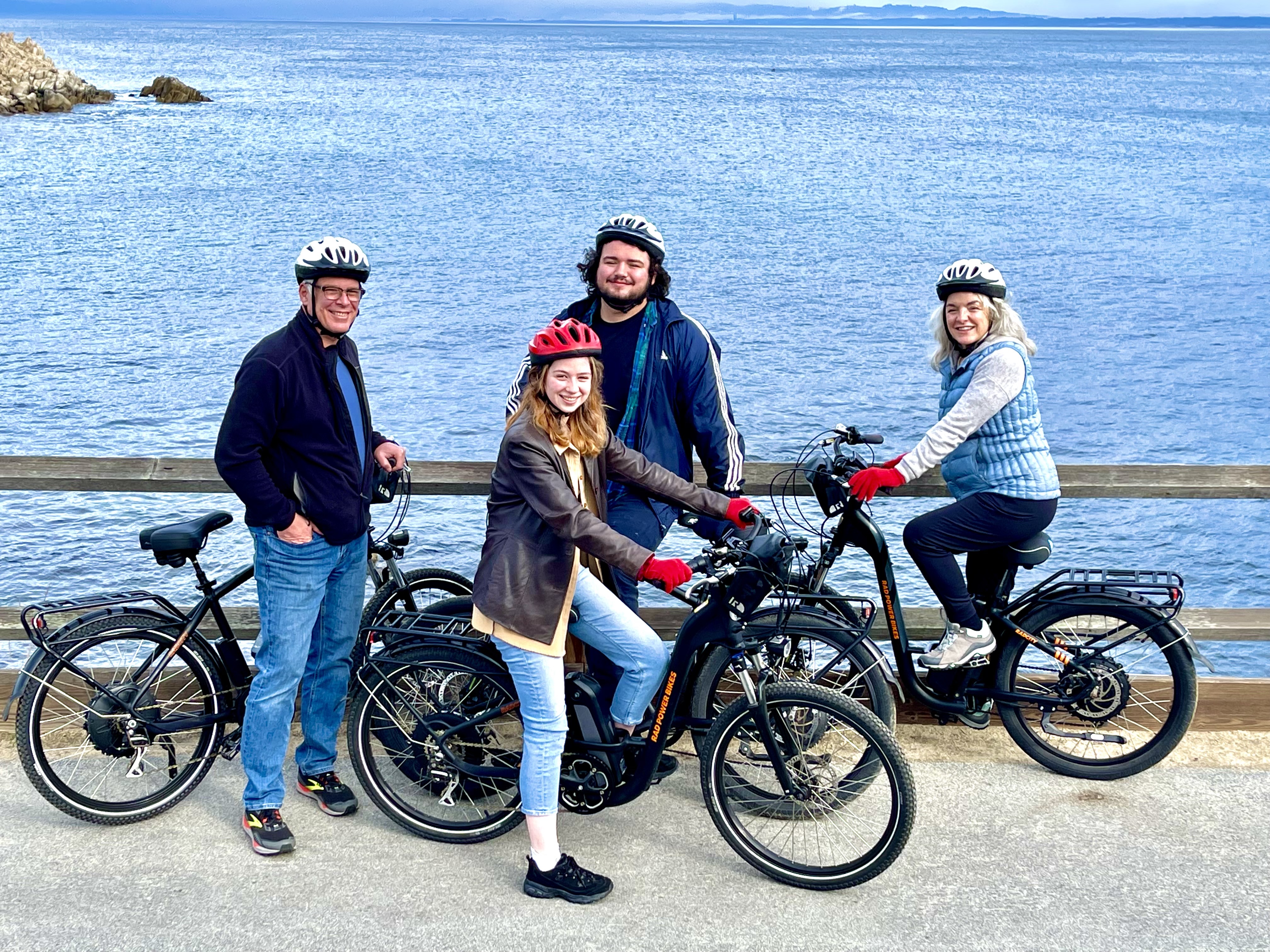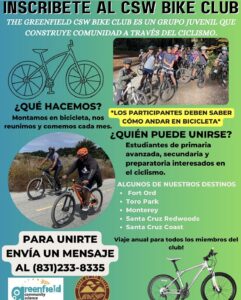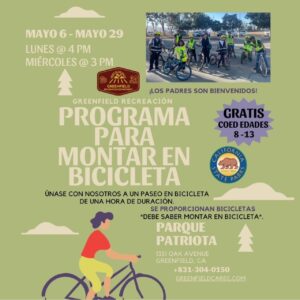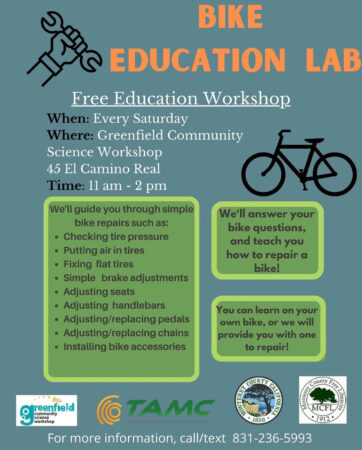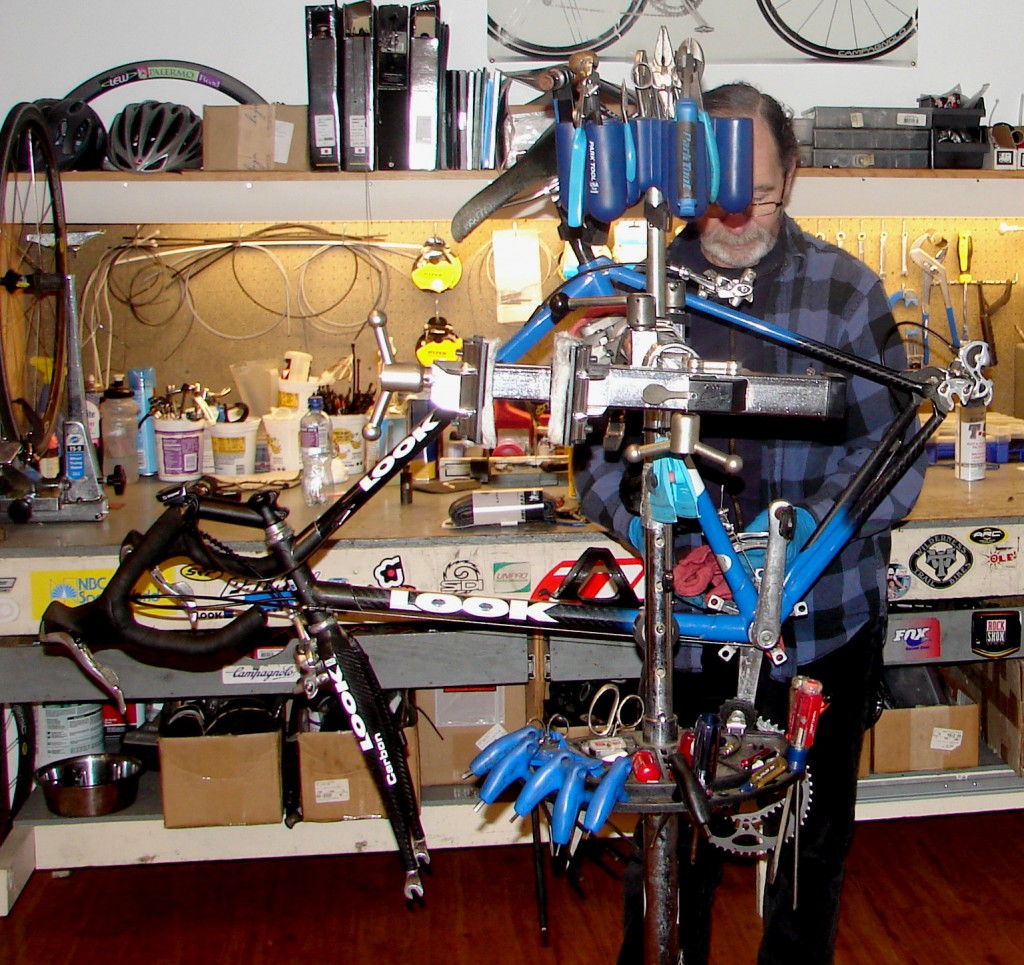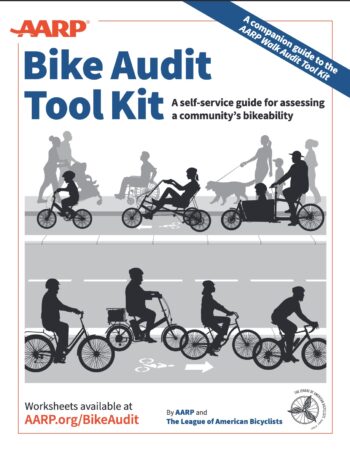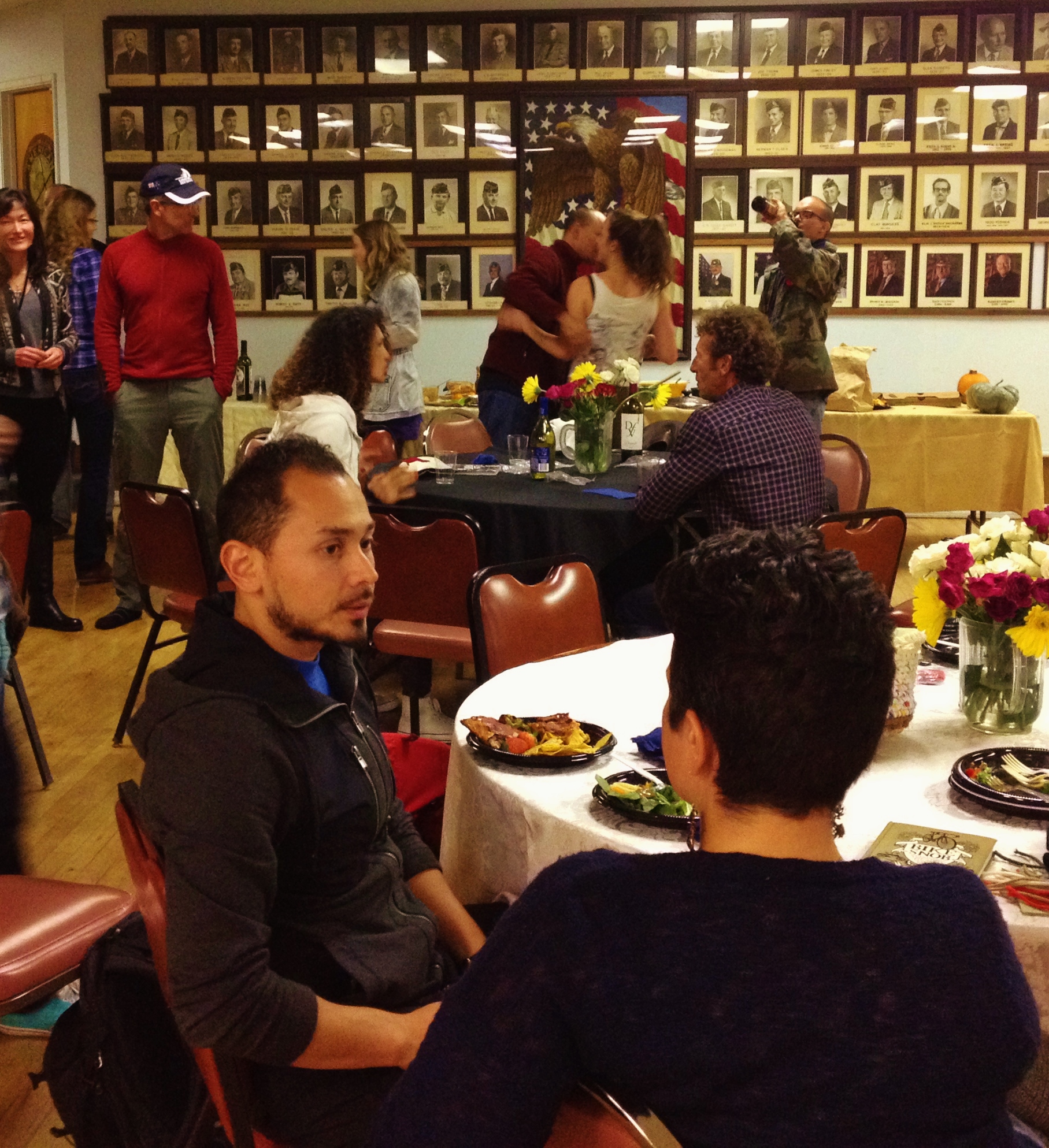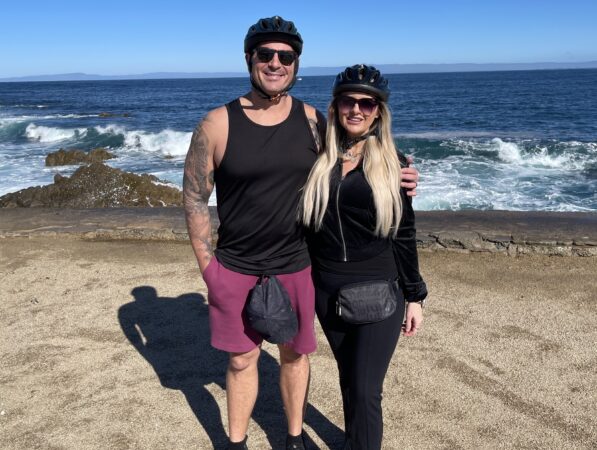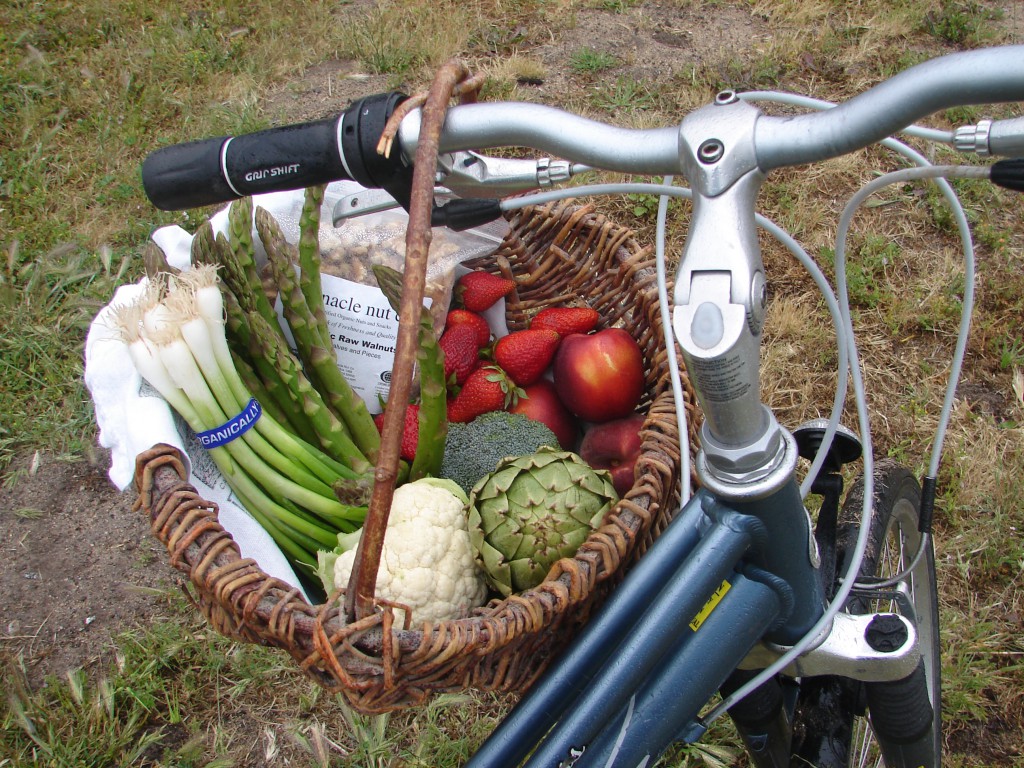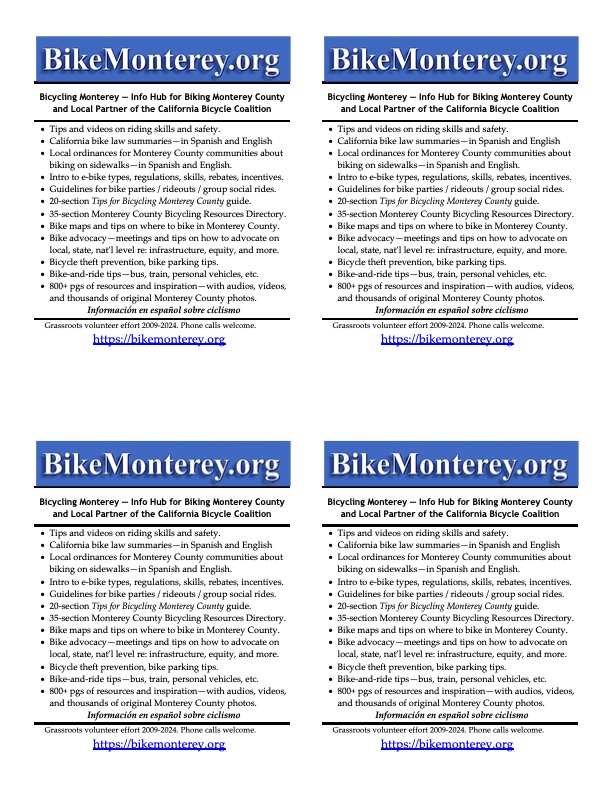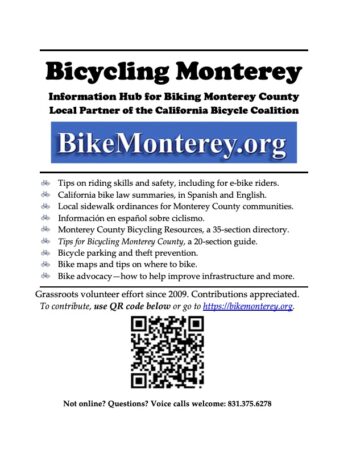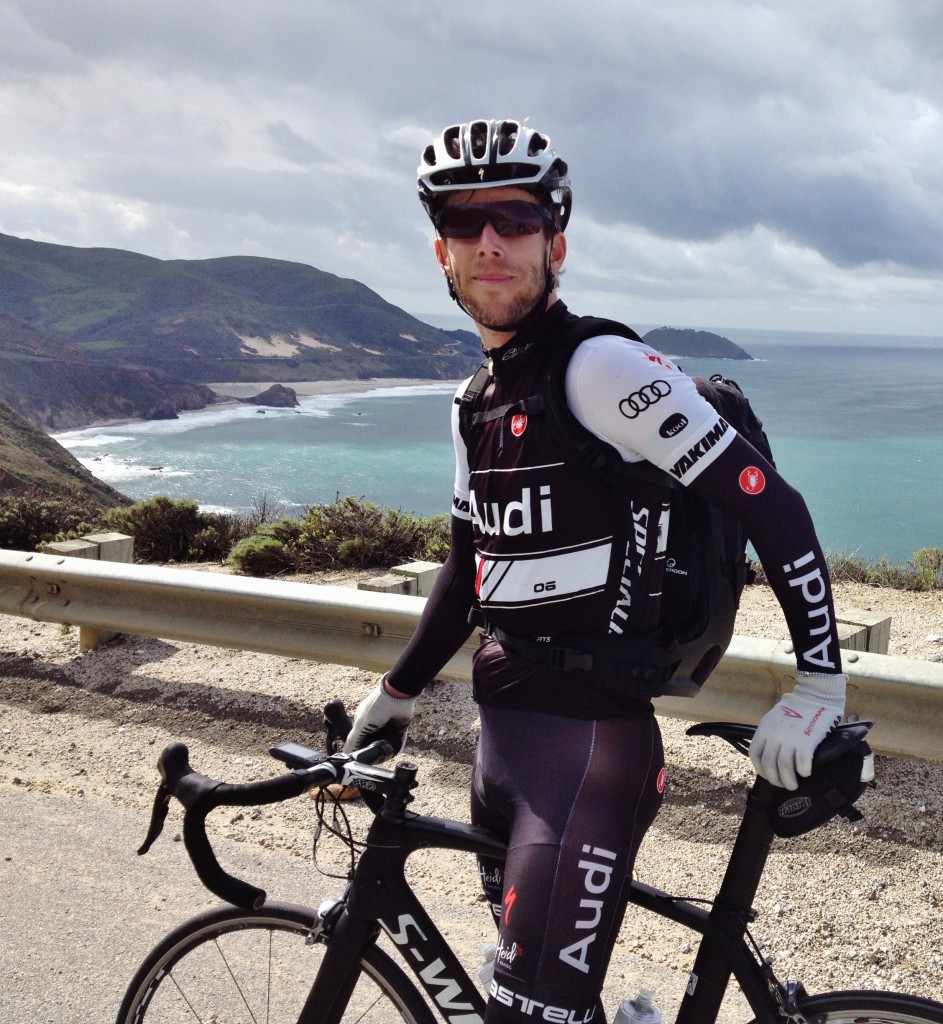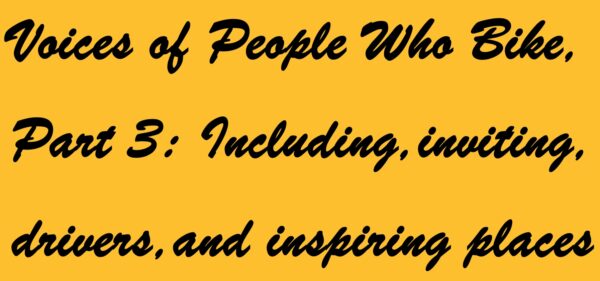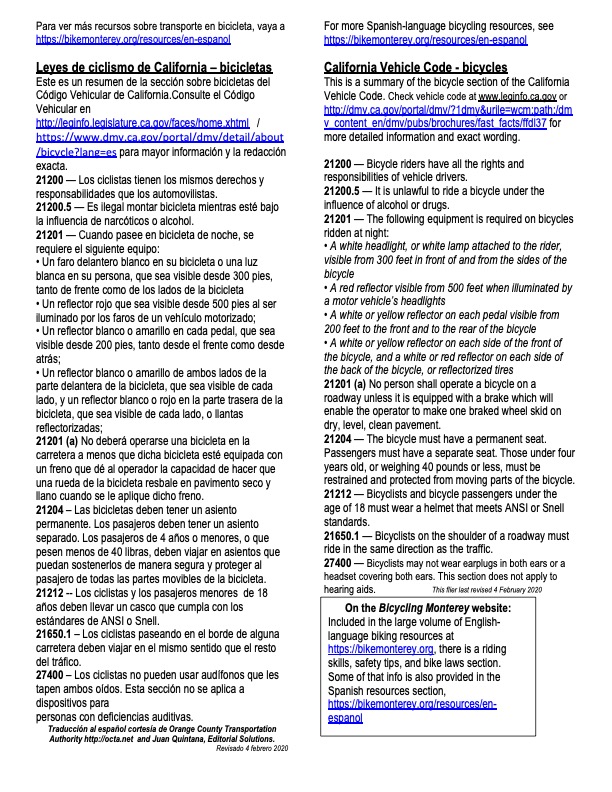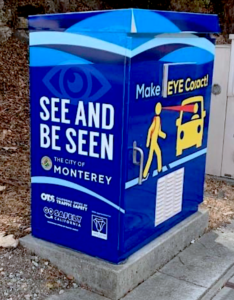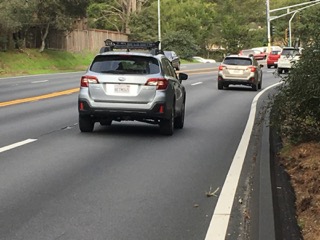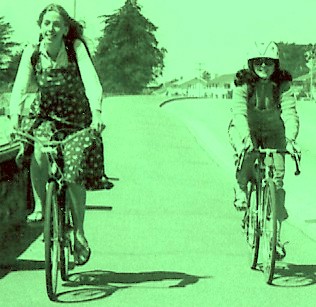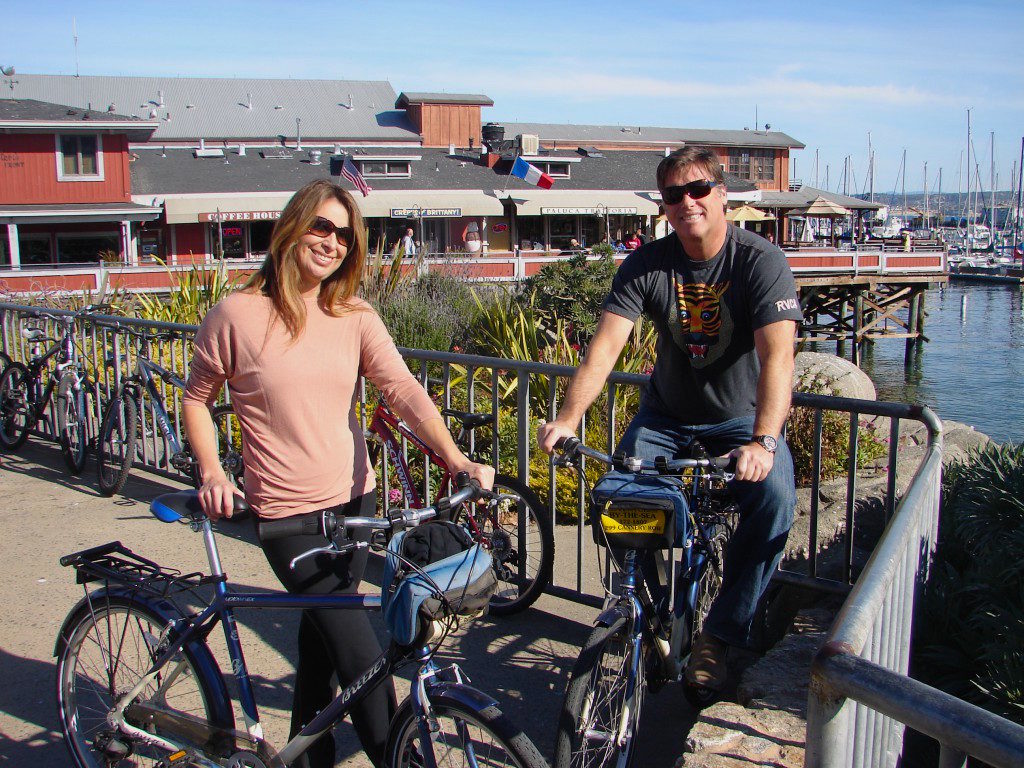19. Night Rides / Biking in the Dark
This guide, provided as a public service, was first published in 2009, with many subsequent updates. For additional updates, or if you have questions, please contact us. To return to the portal page of the Tips for Bicycling Monterey County 20-section guide, click here.
Love night rides?
Me, too! As I describe in “Night Ride Home.”
And since HER Helmet Thursdays discounts apply from 12:01 a.m. to 11:59 p.m. on Thursdays year-round, more people in Monterey County are biking in the dark all the time.


Scroll down for Legal Requirements for Biking “During Darkness”
You may also wish to consider that “A yearlong experiment with nearly 4,000 cyclists in Denmark found that those who used front and rear daytime [emphasis mine] running lights had 19% fewer crashes that caused injury than those in a control group,” as reported in a July 1, 2017 Wall Street Journal story by Rachel Bachman, “How Cyclists Can Stay Safe on the Road: Bright colors, bright lights and positioning on the road can help cyclists be more visible to drivers.” You can check out that study at: http://www.ncbi.nlm.nih.gov/pubmed/22884376.
Before we go on to tips about night riding…
The following are some of the Monterey County evening and night group ride opportunities that have taken place over the years. Check with the organizers for updates:
- Monthly Twilight Rides at Laguna Seca. Note that in the winter season, Light & Motion typically has loaner lights on hand at these rides.
- Monterey Off-Road Cycling Association/MORCA) scheduled night rides.
- Critical Christmas Monterey aka Lighted Bike Parade, normally an annual event.
- Sea Otter Classic had its first night rides in 2013 and 2014—a complimentary recreational ride for all ability levels, with choice of mountain or road course. Check with SeaOtterClassic.com for an upcoming night rides.
Possible eve/night group ride ops:
- July’s annual California Rodeo, Salinas early evening parade, Kiddie Capers, has many kids who bike. However, through 2016, the Colmo del Rodeo night parade still awaits an organized bike presence. Visit the California Rodeo site for details and application deadline. For a gallery of kids and parents biking in the Kiddie Capers parade, click here.
- The annual Salinas Holiday Parade of Lights takes place in early December. The Holiday Parade of Lights celebrates “One City, Many Cultures.” Some Salinas Bike Party riders biked in this parade in 2012, as evidenced by the precious little girls in opening scenes of a Salinas Californian video clip, “Holiday Parade of Lights.” The girls were waiting to watch their papa, a Salinas Bike Party rider. If you’d like to organize a bike presence in the Holiday Parade of Lights, visit their website and apply by the deadline.
- Pacific Grove Holiday Parade of Lights has included, for example, the “family bikes” AKA surreys, rented by local bike companies.
- Salinas Bike Party, a courteous social bike run, had several organized rides in 2012-2013 and may continue to schedule them (or not–SBP says they may support other local biking activities instead). Email salinasbikeparty@gmail.com to check, or look for any updated info on Bicycling Monterey’s main resources/bike community page.
- MenstrualXCycles (grab their contact info on the Monterey County bike community page) has had nighttime as well as daytime group rides.
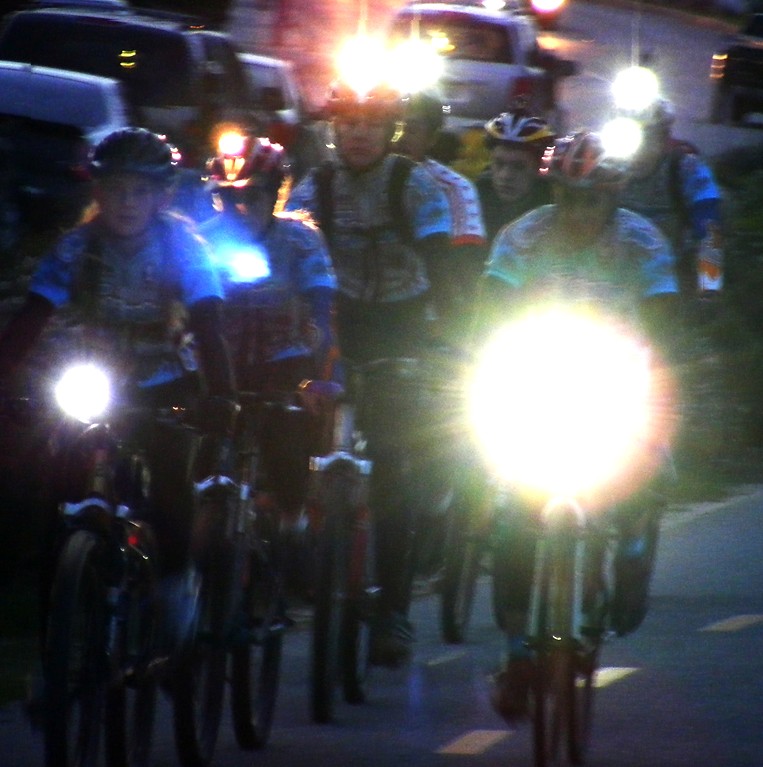
Monterey County’s NorCal mountain bike teams, like Monterey Composite (above) and Salinas High and Palma High (see all three teams in Serious Cyclists) are fortunate to have a safe setting for night-training–even though (since Fort Ord’s mountain bike trails are normally closed at sunset), it’s all pavement.
Where? Miles of Class I bike/multi-use path of the Monterey Bay Coastal Trail, day or night. If race training, please bike slowly around pedestrians, people in wheelchairs, children on bicycles, etc. Better yet, bike north of the busiest areas; you’ll usually have many wide, open stretches with no one to interfere with your race-training speeds. (See Monterey’s countywide map and other maps in Bicycle Maps section.)
Pleasures of night riding include sunsets like this one on October 6, 2013, following the first Ciclovia Salinas. Temperatures were warm, and I biked Salinas until 10 p.m.–just couldn’t get enough!
Below, one of the many local youth who bike.
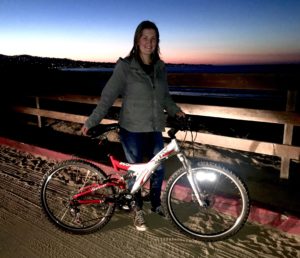
And her sister, Kaela…
There are lots of people who love night riding, all around the world. See some of them in the 2 minute, 34 second video from People for Bikes, “Bikes Make Life Better” (click here for “Salinas Youth…,” then scroll down).
What about local bike commuters? Do they ride at night too? For just one example, see “When No One Is Looking: Who cares about climate change?”
Bike-and-ride options including Monterey-Salinas Transit (MST) can be helpful. Maybe you didn’t bring bike lights because you hadn’t planned on night riding—you were just having too much fun, and the day got away from you! At such times, you may not need to call a family member or friend to give you a ride; check the MST schedule: http://mst.org/maps-schedules/overview/
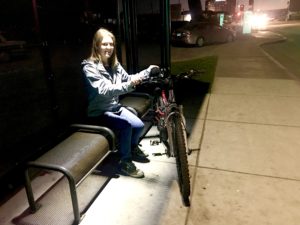

Legal requirements for biking “during darkness”
For California laws regarding required equipment for biking in the dark, see: http://leginfo.legislature.ca.gov/faces/codes_displaySection.xhtml?lawCode=VEH§ionNum=21201.
Pass the news to your ride buddies by sharing Be Cool, Be Safe – Bike Law Summary & Advocating for Biking. Don’t think your buddies will care? Maybe they’ll listen to musician Sarah Factor’s night riding story; click here.
Spanish? The DMV website still does not include Spanish translation of that text as of October 22, 2013. However, Spanish translation is available on this site’s en espanol webpage–or just download PDF here: Leyes de ciclismo de CA – Laws for bicyclists in CA (Spanish, English) – Summary.
Sidewalk riding at night: Check with local cities and unincorporated areas where you ride to be sure they don’t have an ordinance prohibiting sidewalk riding at certain times of day. For example, the City of Greenfield does, in their municipal code 10.28.040. For some other local cities’ ordinances, you might start with the sidewalk section of Bicycling Monterey’s “Riding Skills, Safety, and Bike Laws” section, which includes links to not just sidewalk ordinances but also additional bicycling ordinances for some local cities.
Many people, like the young man below, find their work or school schedules make it necessary to do errands or shopping at night, even if shopping by bike. Check the shopping section for cargo-carrying tips.
More safety tips
See CA Bike Laws and Personal Safety. Of course, another way to be safer riding at night (or daytime) is to advocate for better bike infrastructure, including more bike paths and lanes. Click here for “Bicycle Advocacy: What you can do.”
Equipment
Below are some suggestions for very inexpensive low-cost options, as well as higher quality night riding solutions worth saving up for.
Equip your bike with, at minimum, the legally required lights and reflectors.
Remember to charge up lights as needed before heading out, and consider making use of high-visibility apparel and accessories too.
Beyond the DMV’s requirements about visibility from a specific number of feet, consider beam pattern and be mindful of conditions such as fog.
Below, high-visibility tape on my bike trailer adds to night riding safety.
Off to an evening concert or worship service? Spoke reflectors, such as “chopspokes” from Cyclelogical, can be low-cost, long-lasting, and add significantly to nighttime visibility.
The dad below (notice the child carrier at rear of his bike) doesn’t have precious cargo with him on this ride. Nonetheless, he still wants to get home to his family in one piece. You’ll see him, night and day, in hi-vis apparel.
Bike lights
Start with local bike shops in Monterey County, or wherever you live. You may be surprised at the many options–and the range of choices to fit a variety of budgets.
Personally, I’ve never had a better headlamp, or taillight, than those made by Light & Motion, a local company. Yes, this world-renowned manufacturer of lightweight, high-powered lights is based right here in Monterey County! Find Light & Motion lights at most Monterey County bike shops, a shop nearer your home, or online. (Want to learn about one of the many ways Light & Motion looks out for the needs of others, right here in their home county? Click here.)
After “making do” with inexpensive lighting for a long time, I saved up to purchase two Light & Motion lights–and so glad I did!
Read “Night Ride Home” to learn why I bought my first, a Stella 120 front light, in 2009. Later, I purchased a Vis 180 for the rear. Both L&M purchases made me a much happier, safer night rider.
Richard Masoner of Cyclelicious is a fan of Light & Motion lights too, as evidenced by his 11/5/13 post on headlights. However, like me (see below), he knows that budgets don’t always allow the light of one’s dreams, so Richard offers suggestions for a range of budgets.
Although a rear light is not required by CA law, it is recommended for safety. (Note: CA law requiring a rear reflector is anticipated to be changed to require that a bicycle operated at night be equipped with “a red reflector, a solid red light, or a flashing red light on the rear. ” Check CalBike.org for legislative updates, i.e., AB 28.)
Shopping by bike? Although a rear light is not required by law, this Del Monte Shopping Center, Monterey security guard knows that in areas like the Center–where there are typically many cars and far fewer bikes–it especially makes sense to do what you can to be more visible.
Low-cost lights, including DIY
Even if bike safety is a high priority to you, sometimes a budget just doesn’t allow getting the bike light you’d like–yet, anyway. Click here to download a PDF from Light & Motion about why it’s wise to move that up your priority list as soon as possible!
Meanwhile, until better equipped, below are some low-cost ideas:
- Many of us had a flashlight on our bike handlebars in decades past. Check out these tips from bicyclelighting.com – including flashlight-type lights.
- Here is a simple do-it-yourself solution for mounting a flashlight to your handlebar, which a bicyclist could do with just about any type of flashlight. Listed here are some Harbor Freight flashlights for under $3 each; there is a Harbor Freight at 117 Abbott Street in Salinas.
- Here is another example of an effective light for cheap that takes one AA battery. There are plenty of stores where you can purchase rechargeable NiMh batteries.
- I love my Light & Motion Vis 180 taillight! It took a while to save up my nickels though, and if you’re not quite ready to spring for a better taillight, consider this: Salinas Bike Party organizers found a taillight with seven light functions, for 99 cents! It was suggested by Salinas Bike Party on Facebook, by one of their FB friends, that folks put a bit of tape over the ON/OFF button, otherwise, it falls off pretty easily. (Hey, ya get what you pay for. Start saving up for a Light & Motion or other quality light.)
Rear lights / Tail lights
As of 10/22/13, California does not require a rear light (only a rear reflector) for biking in the dark. Nonetheless, a rear light also makes sense! Click here to download a PDF from Monterey County-based Light & Motion about improving rider safety with a new generation of lighting. For the Vis 180 referred to, and other commuter bike lights from L&M, click here.
I saw a cyclist with the most wonderfully visible tail light on his bike one evening, and–taking care not to approach him at night in a way that could feel threatening–I inquired. In replying, this touring cyclist, Wyatt Wood, recommended DiNotte, and he had these additional helpful comments:
I receive so many compliments *in broad daylight* that I run this tail light all the time on that bike *when I am riding alone*. I’ve had cops, bus drivers, etc, pull up next to me and say “Great lights!” or something similar. Motorists talk to me when I am stopped, and it’s always extremely positive. They really appreciate that I am so visible. Remember, I’m talking daytime. At night they really stay away from me.
Cyclists in “stealth clothing” get really upset when another road user says “I didn’t see them!” Well folks, it’s often the truth.
The downside of the light you saw me running is that it’s too bright to have it in another cyclist’s face, so I have to use a “normal” tail light for those situations. I have a similar light on one of my tandems, but it’s under the rear rack, so a cyclist right behind looks over it.
I’m fully aware that only a very few cyclists really want the sort of lighting I use, and they’re mostly serious commuter types. Since I am asked so often about my light [which he custom made], I’ve gotten used to suggesting the DiNotte. While it isn’t as “over the top” as what I make, it is “daylight visible,” and slick enough to sell. It’s a bit pricey, and if there are cyclists behind you, you’ll need to *not* use the brightest setting; but for the general market, it’s one heck of a light.
The trip where you encountered me was one I do a few times each year. I refer to it as “Going Coastal.” I love to do the Big Sur Coast at night. There is virtually no traffic, and with the lighting I use I really show up.
More high-visibility accessories, and apparel
Hi-vis items are smart during the daytime and essential at night! See high-visibility apparel and accessories section for tips.
This man’s vest keeps him highly visible on the bikeways, day and night.
Street Smarts
Look over the tips on night riding in John S. Allen’s book Bicycling Street Smarts: Riding Confidently, Legally, and Safely. Versions of the book include a California edition.
Night on the town, rolling up to an ATM–one of our Santa Cruz neighbors.
This young man in Seaside gets his dog out to enjoy the night air too!
“Are those lights I see around the bay?”
Some visitors have asked about lighted bike paths. If you are a long-distance cyclist and find yourself arriving here at night, or taking off before dawn, you may appreciate the lighting along many sections of the bike paths. From the north end of Sand City to Fort Ord, there are 3′ ballards that shine onto the path, and these don’t interfere with views of the night sky.
A stretch of trail that enjoys an uninterrupted view of the night sky–though beware of “cool with a chance of fog.”
(Photo courtesy of Leo Kodl)
For much of the City of Monterey portion of the bike path, and for a three-quarter mile stretch of the seaward side of the bike path from Humboldt Street in Seaside to Tioga Avenue in Sand City, there is also lighting. However, these areas feature 25′ tall overhead lamps that shine down on the bike path, which demonstrate one disadvantage to lighted bike paths: adverse effects on views of the night sky! Another downside to bike path lighting is energy use.
Just how valuable bike path lighting is to personal safety (especially in terms of preventing a bike crash) is debatable. However, a good personal biking headlamp (a front light fastened either to your handlebars or helmet) like those discussed above is highly recommended!
Lighting on bike trails may have more value, however, in terms of preventing nighttime assaults in these often isolated areas. Is this common in Monterey County? No. Nonetheless, common sense precautions are in order.
Safety
Use common sense. In some locations, it makes sense to bike with a friend, or even in a group.
Changing your usual route is sometimes wise at night. For example, some cyclists might skip the multi-use/bike path at night and instead bike in more traveled areas, even if it’s a road shared with cars–and sometimes even a sidewalk (more on sidewalks in the CA Bike Laws and Personal Safety section).
Here’s one example of what helps make this a safer county for people who bike: excellent local law enforcement. See a sampling in “Constables of the Peace–Cops on bikes.”
Looking for great places to star-gaze?
No doubt about it, there’s a lot to be said for being at a high altitude during the annual Perseid shower. A trip to the Sierra is mighty appealing come August. But I’ve seen many a shooting star right here in Monterey County, including directly on the coast in Big Sur, way out Carmel Valley Road, out many other rural roads, and–though not on a foggy night–even in my own backyard, about a 20 minute bike ride from the coast.
A big plus about being outdoors in Monterey County at night: no need for bug repellent. I think I’ve swatted a maximum of two mosquitoes since moving to the Monterey Bay area in 1976.
One place where I’ve loved star gazing is Fremont Peak. Fremont Peak State Park falls in two counties of the Monterey Bay region. The majority is in San Benito County, and the northern tip is in Monterey County. My first good look at the rings around Saturn was courtesy of some Stanford students who brought their telescopes there one night long ago. Head on up and make your own night-sky memories! Fremont Peak State Park
Many other federal forests and state and regional parks are a good choice, too. Check them out in the Camping in Monterey County post.
Most years for the Perseid shower, getting away from the coast a bit is a good idea—due to chance of fog, as well as city lights. There are many rural roads with wide open skies that offer great opportunities for star-gazing. To avoid frustration (running into neighborhood dogs, private property signs, and the like), check things out a bit earlier in the evening so you are all ready to kick back and enjoy when those meteors start rapid-shooting into view.
Pack up a tarp to stretch out on, along with some warm clothing (it’s rarely warm in MoCo at night–so this advice applies not just to December’s Geminids but to the August Perseids too!). And remember your bike lights and such for that return trip in the dark. For many locations, you may want to do the bike-and-ride, perhaps putting your bike on your car’s bike rack and drive part-way there, then bike the remaining distance to your primo star-gazing spot.
If you want to keep tabs on the night sky, or perhaps even attend one of their star parties, visit the Monterey Institute for Research in Astronomy (MIRA) website. Also see Earth Sky.org for annual updates.
Check in with Monterey Peninsula Regional Park District too. For example, in 2015, they hosted a free Perseid-watching party at Garland Ranch Regional Park. Understandably, rain, clouds, or fog cancels their event. For more info or current weather, call 831-659-6065.
Late-night food
Large metropolitan areas have many more places open late at night, but that’s okay, we prefer the charms of Monterey County. When you are looking for late-night dining, where to go? A few HER Helmet Thursdays participants—Sakura Japanese Restaurant, New Monterey; and Terry’s Lounge at the Cypress Inn, Carmel—are among Monterey County’s late-night food spots outlined by Mark C. Anderson in the Monterey County Weekly.
High visibility? Keeping it fun
Discovered this one on the Portland Bureau of Transportation website. If you want a good chuckle, see Let’s get visible (B:C:clettes’ video).

